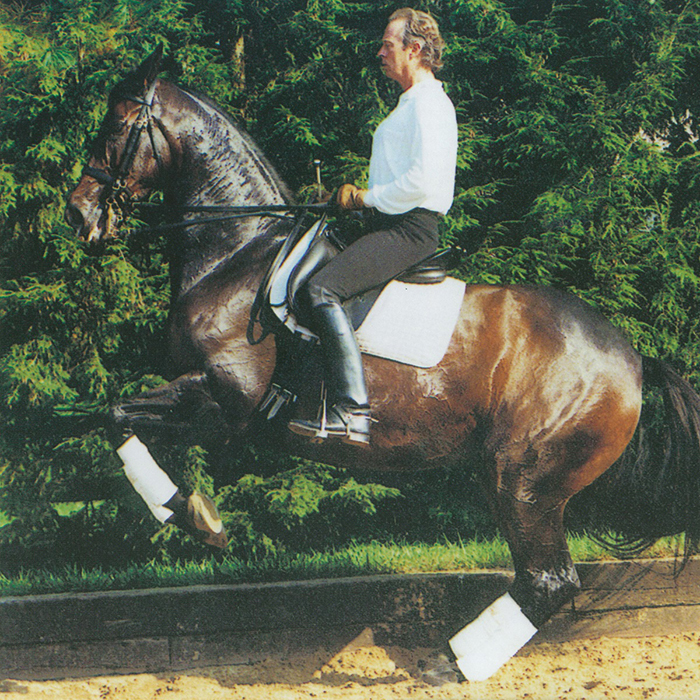
In the past year I have been enthralled by two equestrian books that could not be more different in their form, while at the same time, sharing an awareness that the heart of dressage is to be found in balance.
Miguel Tavora’s Dressage Principles and Techniques is like the most wonderful cookbook. Here there are recipes, and step-by-step techniques to achieve the most wonderful of dishes – a balanced, ‘dressed’ horse. Paul Belasik’s new work, Dressage for No Country, also sets out to find the truths that are at the heart of dressage, but his is an intensely personal quest, shaped largely by the remarkable (and not so remarkable) individuals he encounters on his quest, and quest it is, Paul like some medieval knight in search of the grail.
Miguel’s work is positively austere, as dry as a fino sherry, what makes it exciting is the relentless logic in the pathway he provides for the rider, as exercise after exercise build to the ultimate goal. That’s it, no reminiscences, no anecdotes rather an almost algebraic sequence of exercises…
Nothing could be more different than Paul Belasik’s intensely personal account of his getting of wisdom. And Paul’s account is made compulsively readable by the fact that he is a great story-teller, and an accomplished wordsmith, aided by the fact that he has met some truly fascinating people.
At the heart of Belasik’s thought is the emphasis on transferring the weight to the hindquarters to achieve real collection.
“I come from a country with no tradition or history of dressage. Dressage, the training of horses with roots that go back to the ancient Greek philosopher and soldier Xenophon 2,000 years ago, has strong similarities to human ballet. Dressage reached one of its highest pinnacles in northern Italy in the 1500s. There, at the riding school of Giovanni Battista Pignatelli, young noblemen came from all over Europe to study this kind of riding.They returned to their own countries of France, Germany, Spain, and England, and although certain nationalistic elements shaded their riding in the centuries that followed, in reality, all the styles were similar. They all came from the same spring of knowledge. This dressage was an art form and discipline. It was an ethical way to train horses and the people who rode and worked with them. It also became one of the most sophisticated experiments in cross-species communication that the world has ever known.”
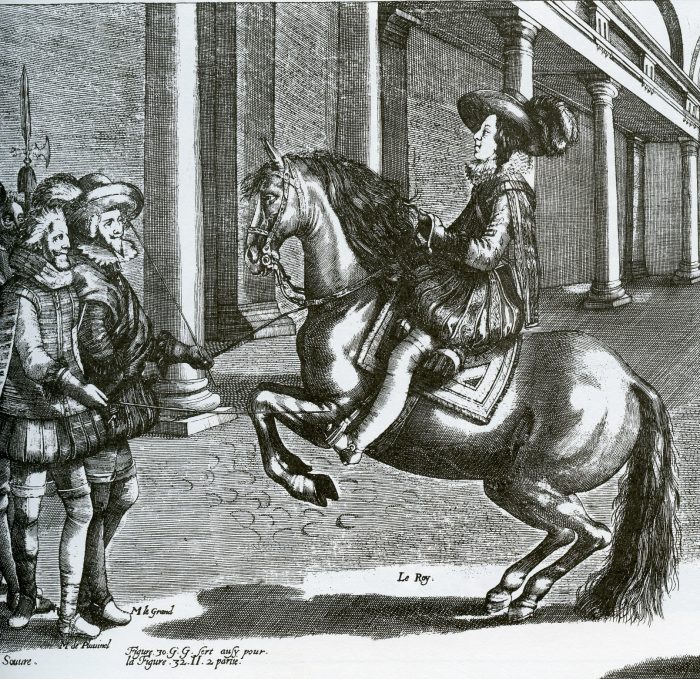
He sets out his aims right from the start:
“This book is about a lifetime of searching and studying. On the pages ahead I will illustrate some of the dressage systems I have studied. I have tried to be ruthlessly honest in talking about the deep problems these systems may have presented to me, and to others. In the end, I talk about what the future of this art form might look like, and how science has always been a partner to is continued development.”
Paul has a very distinctive take on the rôle of the Warmblood in the development of modern dressage, and lays much of the blame for what he doesn’t like about the German style and the tendency to breed for a rectangular Warmblood who finds it hard to shift the weight to the hind end.
Paul, who was then an eventing rider, was lucky to ride some of the first Trakehners that were imported to the States, including legendary showjumper, Abdullah, and was drawn to the horses, and the philosophy that went with them:
“Today, if one speaks about the ‘German system’, it is likely to involve the Classical Training Scale, consisting of six principles,often depicted in a pyramid shape, implying ascension from one phase to the next. This pyramid is an overly simplistic graphic; the German system that I studied and learned was not perfectly clear, nor was it simple. Some of its strongest messages and best advice were below the surface.The system I learned had several key elements. The first might seem obvious: young horses were started and ridden more for versatility, in the style of eventing. They had to be round and on the bit, capable of dressage movements, but not at a very high level, as they were immature in body and mind. The early training in preparation for jumping was probably more important, especially from an economic point of view, since prices for jumpers at the top of their field dwarfed prices for dressage horses at the top of theirs. When a horse did specialize in dressage, The Principles of Riding: The Official Instruction Handbook of the GermanNational Equestrian Federation gave the following advice under ‘further training for the specialist horse’, plainly stating,’All these high school [airs above the ground] are very rarely executed and only by especially suitable horses. It is therefore unnecessary to provide further explanation.’ It was clear that training ended at piaffe, passage, and pirouettes, that we were not to pursue movements where both of the horse’s front legs would come off the ground at once. The horses were to be ridden athletically forward.”
next we talk about Paul’s view on the ideal the shape of a horse
And then we find the shape issue, I don’t think I agree with Paul’s analysis, but it is a thought provoking one:
“The great Dr Fritz Schilke, a father figure in the German breeding scene (particularly Trakehners, in his case), insisted that horses be bred for conformation that fit a rectangular frame, as opposed to the squarer frame of the Thoroughbred or Iberian horses. I’m certain that, at least in some part, this came out of a carriage-driving heritage where the Warmblood horse was admired for a ‘floating’ trot. In fact, this breeding model has not significantly changed in philosophy. The Director of the Hanoverian Verband (Association) as of writing, Dr Werner Schade, was noted in The Horse Magazine’s article, What Made German Dressage Great, as saying, ‘The formation of the neck, the shoulder, the saddle position, the topline, the hind end construction, the uphill construction, the rectangular frame are some of the most important conformation criteria.'”
Later Paul details what he sees as the problem:
“Over the years, though, as I rode and studied the art of equitation, I began to find problems with this rule of conformation in that these ‘long’ horses were more difficult to collect. It was early on that I began a lifelong habit of measuring the length of a horse’s back, finding a direct correlation between that length and his ability to collect. (Or, at least, a connection between the length of the back and not being able to collect.) When I say ‘collect’, I mean in the most simple terms that the horse would use his lumbar-pelvic muscles the iliopsoas and psoas, among others, to ‘curl’ his hindquarters under, so that if you drew a line from the point of the buttocks to the ground, the hocks would be in front of the line and not buried in the hair of the tail (behind the line). Even when a horse shows marked flexion in his hocks, stifles, and hind legs, and lowers his hindquarters, he is not necessarily demonstrating ‘classic collection’ if his hips do not come under his body in the way I’ve described.”
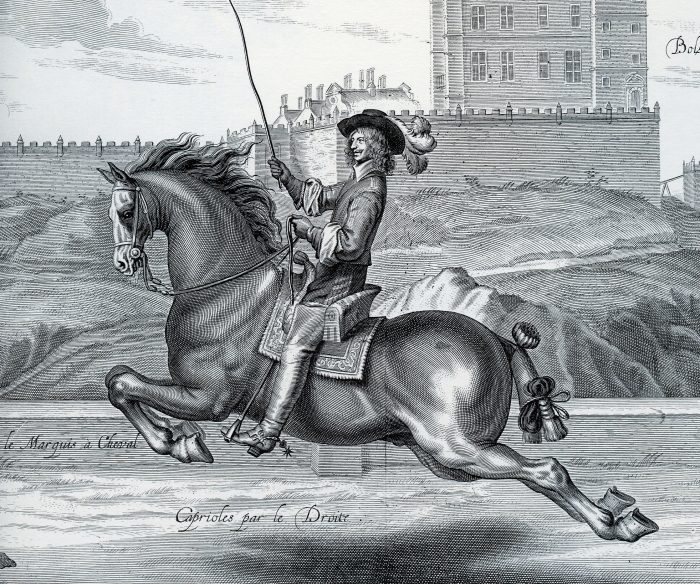
“The notion of ‘true collection’ is a simple and ancient one, which came from the fact that the old dressage masters loved the airs above the ground – the series of high level, classical dressage movements in which the horse leaves the ground. For a horse to raise his front end off the ground, he had to rebalance his weight toward the rear, widen his stance, and bring his hind legs under his mass, like a weightlifter getting under the weight to be lifted. It was simple physics. Even if a rider did not aspire to airs above the ground, lightening the horse’s forehand and rebalancing him toward the rear became the raison d’être of dressage.”
And in Paul’s view, the German system fails because even its Masters cannot perform a levade…
“Schultheis was extremely influential, winning the German Dressage Derby himself eight times and coaching the German dressage team, as well as many successful competitive riders outside Germany. Perhaps no one embodied the German ‘driving seat’ and German training system as much as Schultheis. The German driving seat could punishingly push into the back of the horse, making the horse hollow in the back and unable to swing his pelvis under the body. As successful as he was, it was Schultheis’s seat that became a lightning rod for criticism of German dressage riding. What became known as the ‘German seat’ was not a compliment at the time.”
“I had a film of Schultheis riding a gray mare through all the movements, up to and including Grand Prix. This was not a video pieced together from the internet (which didn’t exist yet) or old footage, distributed in order to show a famous rider in an unflattering light. It was an official training video to be used as a good example of how the movements should look as they were executed by a master. I studied the video as if that was what was intended. However, the stand out feature of the film was not the one intended, I am sure.”
“Schultheis’s back and upper body were ramrod straight, but his legs were in front, and he was slightly chair-seated. Unfortunately, also clearly on the film, Schultheis’s punishing seat and back drove down and into the back of the long-framed horse in an obvious attempt to increase engagement and impulsion. It had the opposite effect, which became painfully obvious in the piaffe and passage sequence where the horse was locked in his hips and unable to curl his hindquarters under his body. The game horse tried to answer his demanding rider with more energy, but with his back locked and hollow, his hind legs could not come under his mass to lighten the forehand. The only place they could go was spasmodically off to the side. It was sadly a failure at true classic collection as defined by hundreds of years of old masters’ theory and practice.”
At this point I cursed yet again that our entire street had been without internet access for over 24 hours, and I could not go in search of the footage of Schultheis and the grey, so I did something extremely retro, picked up a book, Harry Boldt’s wonderful big book as I knew there were photos of Willi in that, but before I got to Schultheis there was a page of photos of Otto Lörke, the absolute master of modern German dressage, whose influence was far greater than Schultheis, and guess what he was doing? Levade – that movement that the German system, according to Paul, can’t produce. Willi Schultheis was apprenticed to Otto Lörke for twenty years.
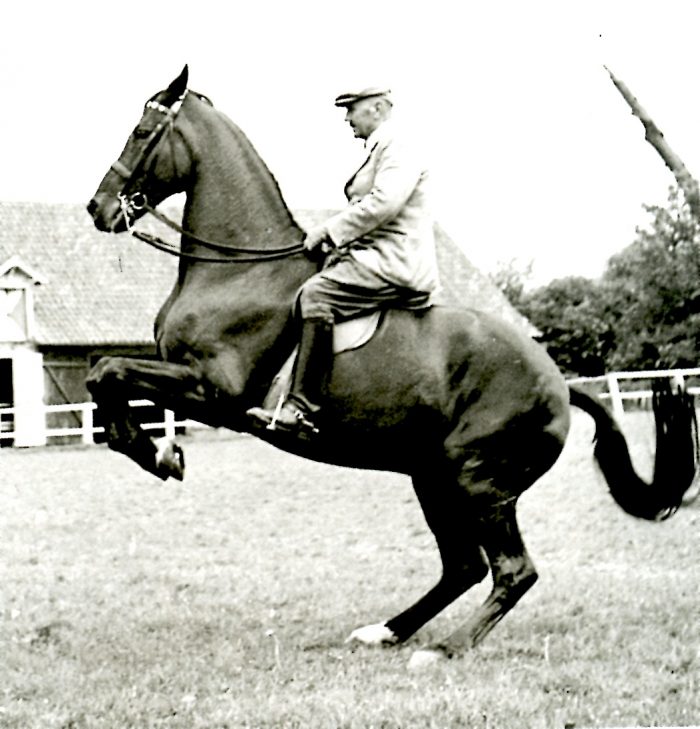
I am not sure about Paul’s critique of Willi. For starters, Schultheis was a great fan of the Thoroughbred and much of his success came with ‘square’ horses like the ex-racehorse, Pernod, and low and behold, there’s this photo of Willi:
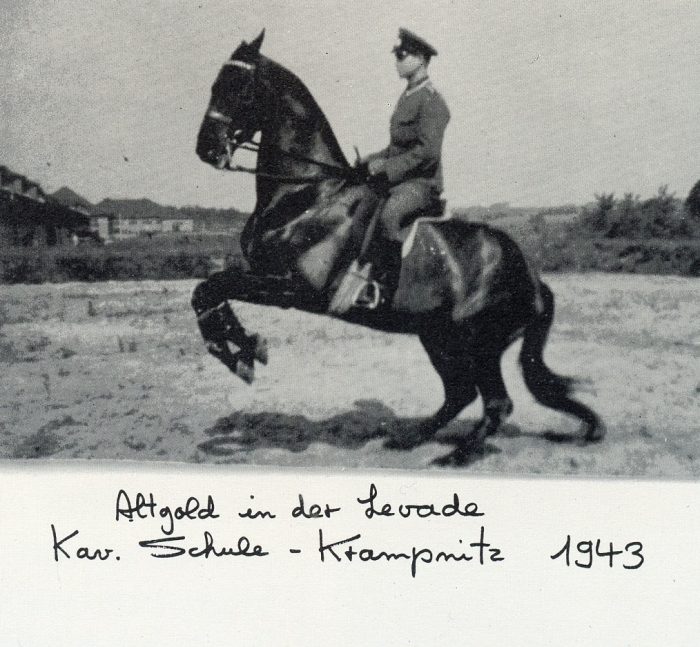
It is certainly not the way Schultheis’ most prominent disciple, Rudolf Zeilinger remembers his master:
“He was a natural artist/talent. His way of riding was more art than a craftsman. He had a big feeling to think very quickly into a horse, to see what is the point, the problems there. The great thing was through the influence of his riding, he could moderate almost all horses to work on his side. He loved especially the Thoroughbred or Trakehner horses, horses that were a little bit more hot in their temperament.”
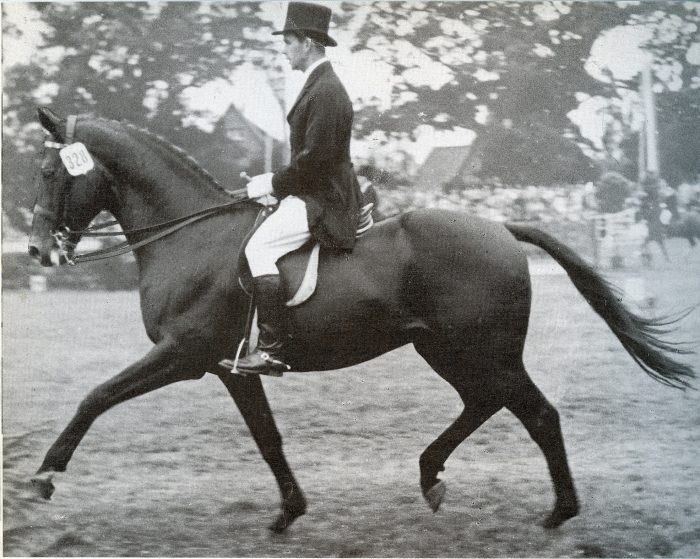
Here is Schultheis on the Thoroughbred, Pernod, winning the Hamburg Derby in 1950, looks to me like a lovely balanced light seat, beautiful hands and a delicate connection – not to mention a horse stepping freely under itself, and yes it is somewhat of a ‘chair’ seat but I wonder if the saddles of the time, crafted more for jumping, did not play a rôle here…
Here’s a link to Schultheis riding Pernod
The charge against Schultheis becomes less plausible when you consider that Willi, like Lörke, was unable to compete at the Olympics because they were ‘professionals’, so they produced a string of horses that competed at the highest levels, ridden by elegant women. Here is Schultheis with his most famous pupil, Rosemarie Springer. The horse looks under himself and in lovely balance.
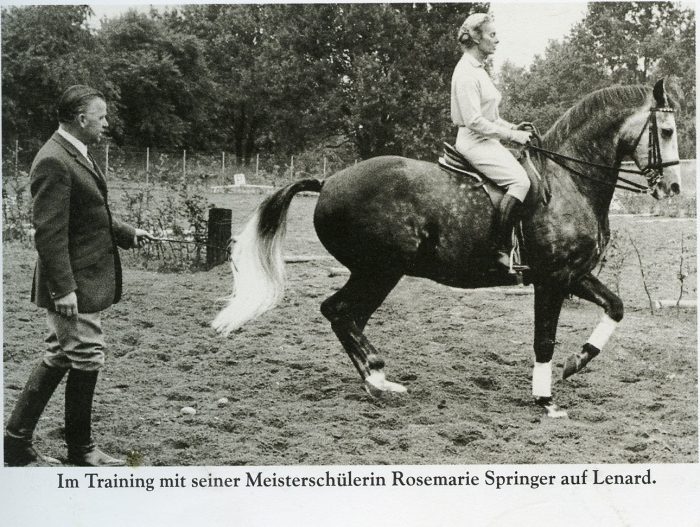
I was lucky enough to watch Rosemarie train and ride on several occasions. The idea of her ‘grinding’ the horse’s back with the seat her immaculately tailored doeskin breeches, is ludicrous. She was an elegant, effective rider even on strange horses with less than perfect education.
Next day, the internet came back, here is the footage that so offended Paul. Okay this is not the best passage – the horse pats down in front a fairly common fault – and it is not really Schultheis’ style of horse – it’s grey and a bit long in the back, and looks like it comes from Holstein. Gentle reader, you make up your own mind, here is the link https://www.youtube.com/watch?v=MpyO3B5dHmQ
The next development in Paul’s journey came when he met Dr Henri van Schaik, a Dutch Olympic showjumping rider, who had moved to the States.
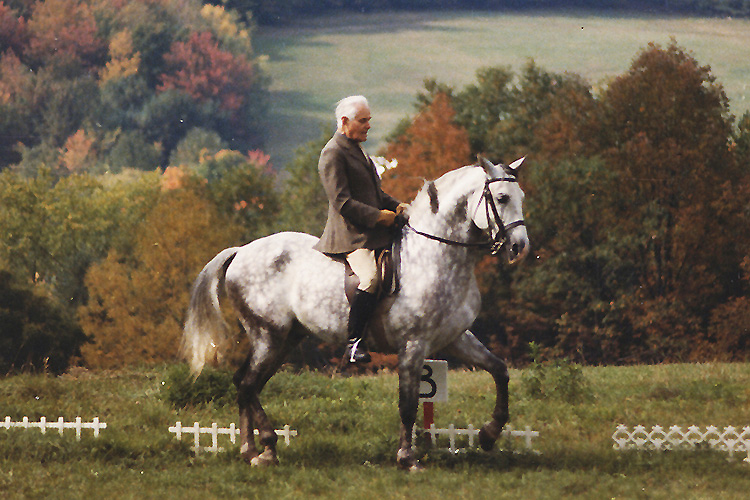
“Throughout his life, van Schaik was captivated by new mechanical innovations and gadgets. He had a computer early on, but for us who became is students, the most important of all was his video camera. He would take trips each year back to Europe, where he would film many great riders in little ‘home-movie’ clips. Today, no rider in his right mind would allow you to film a training session for fear some small piece, taken out of context, would appear and ruin a career, but somehow the riders back then trusted him and let him do it. He used the clips to illustrate his teaching and his philosophical points.”
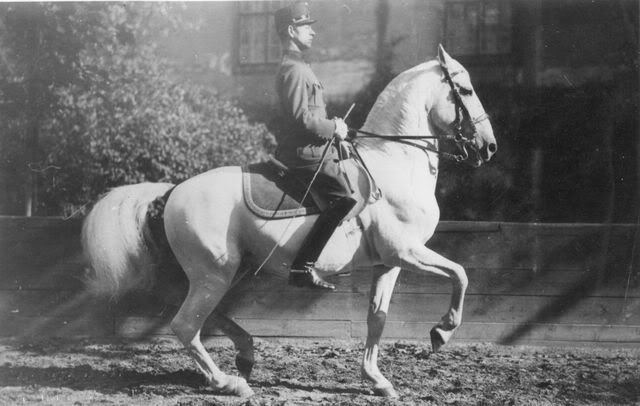
“There was one clip that stood out from all the rest. It was comprised of two short segments, showing Egon von Neindorff at his small school in Karlsruhe, Germany: one in the evening, with people watching from the doorways, and the other the next morning when he is all alone on the arena. He is riding an Iberian horse, Jaguar, in a series of movements: In the evening, there are some extensions out of a piaffe and trot that seem impossible in their power and scope. The next morning, there is a series of piaffe and passage. To this day, these are some of the most amazing piaffes I have ever seen – highly cadenced with extreme power, the horse teetering on the edge of a levade with great rhythm. All the while, von Neindorff sits in perfect form, quiet, motionless, balanced, as his horse’s hind legs come deep under his body. It is the embodiment of the classical idea of collection, almost to an extreme.”
The next step along Paul’s path was Portugal, and Nuno Oliveira, but in preparation, he studied the works of Baucher, whose influence, Oliveira had often acknowledged. Belasik’s critique of Baucher is superb:
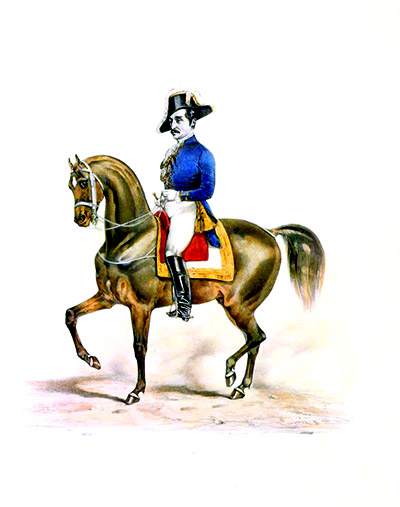
“It is Baucher’s theories and own words that are the most confusing; they eventually condemn him as a false prophet of lightness. Baucher has by now been reinvented so many times by his followers that one might think he walked on air. Truthfully, he did not write very much himself, but there is enough to provide a more accurate picture than that painted by his acolytes. When one reads his own words, one doesn’t get the sense that he was some angel on the horse. He wrote about complete submission from the horse, and the need to destroy any will to resist. He drove the horse from the legs and spurs so hard that his own legs had to be wrapped in bandages and the horse had bloody flanks. Then, he stopped any resistance or attempt to run through the bridle by inventing and incorporating severe flexions of the horse’s jaw and neck.”
Paul makes the even more sophisticated point that while Baucher achieved lightness in the hand, it was not because he had transferred the horse’s weight to the hindquarters, rather he aimed for an equality of weight in all four legs…
“When Baucher discouraged classical collection and said he invented something new, he did. He actually tried to redefine dressage by redefining collection, because he simply eliminated it. He encouraged the horse to balance farther to the front, giving the horse a larger base of support. Balancing the center of mass and finding equilibrium is much easier over four legs than over two. Even without video to watch, you can prove this was his goal from his stated requirements in different movements: For example, in the piaffe, the horse’s front and hind legs should move up and down at equal heights – no loading of the haunches. Seeger described Baucher’s horses as having no impulsion. Yet even if one added more energy to this frame, the hind legs might flex more, but they wouldn’t come under the horse’s body to carry more weight.”

“Baucher’s idea that dressage could still be achieved by letting the horse go more on the forehand would become central to understanding a ‘new school’ of lightness, which diverged from the de la Guérinière (and others) idea of lightness. The latter is about lightness in the horse’s front end developed from exercises to increase the strength of his hind end. The former emphasizes lightness in the bridle, which becomes much easier if you increase the severity of the bit or sensitivity to it, while allowing the horse to use his front legs to help carry the load.”
Paul’s critique of Nuno saddens me, not because it is not accurate, it is crushingly so, but I liked the guy and enjoyed the time I spent with him (though not the time spent with his precious and pretentious fan club) and I also learnt much – but I have always been worried by the frame and the way of going in the hands (and seats) of his followers.
I remember a German rider / equestrian journalist, who was based in Australia for a while, and she had seen a ‘lesson’ conducted by one of Nuno’s more prominent Aussie acolytes – it was crazy, the horses strutted around is a little shuffling trot, hollow in the back and all in double bridles and none on the bit…
Belasik nails it, Nuno is tainted by the same concept of balance as Baucher:
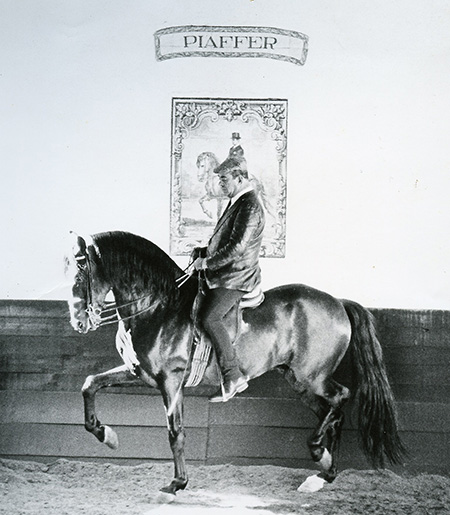
“In the riding and training, again it seemed almost opposite to what I had been learning from the German training system. Very young horses were ridden in full bridles. One didn’t encourage the horse to seek the contact, it was rather the opposite. When a horse leaned on the bit, he would be ‘broken off’ the contact with flexions of the jaw or neck. This often produced horses that were flexed at the third vertebra, bending farther back in the neck and carrying their heads low instead of being flexed at the poll and keeping the poll at the highest point. The rein length was long and often looping, giving an impression of lightness ofthe hands.”
A telling final word on the ‘newer school of lightness’:
“This school of dressage was missing something, namely the training of the lumbar and pelvic muscles – the psoas and iliopsoas- to flex; it lacked a replicable exercise repertoire to build these muscles and then have the strength of the back and hindlegs to pull the horse’s front end up. There was endless leg-yielding,trainers forgetting that there is an inverse relationship between sideways movement and impulsion and power. All the side-passing was sending the horse’s hind legs past his centerof mass, effectively teaching the horse to disengage the hind end, not engage it. Exercises like the Spanish walk completely hollowed the back and forced the hind legs to take spasmodic, almost string-halting steps, again completely disengaged. There was too much infatuation with backward riding: too much reining back, even cantering and piaffing backward! Horses go backward when they are nervous and psychologically submissive, or if they feel trapped. To me, this especially was the antithesis of the great French horseman Alexis-François L’Hotte’s teaching:“calm, forward, straight.”
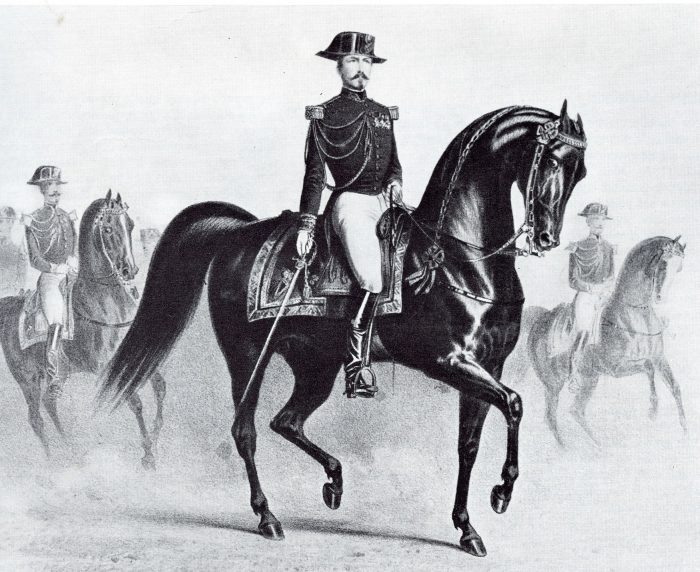
General l’Hotte – calm, forward, straight
And the final blow:
“By obsessing on the weight in the reins, ‘reins of silk’, ‘riding with a string in the mouth instead of a bridle,’ no bridle at all, or using flexions to get the horse to drop the bit, these riders, like Baucher, had opened up the horse’s base of support and encouraged him to put more weight back on his shoulders (rather than the hindquarters) by allowing a longer rein and often a lower neck. This changed the frame of the horse, putting his center of mass more toward the forehand, which in turn made it easier to balance him. I think riders became seduced by that feeling. It was easier, it seemed kinder, there was no sweating. It often used the increased ground reaction force (the force exerted by the ground on the body in contact with it) on the horse’s front legs to display more ‘action’ in the front, and this was ‘proof’ that the horse was light. When one did this, one could get the horse lighter in the hands and lighter in the bridle, but he was not being prepared for the hard work of collection. He was not being made stronger, like a weightlifter developing the proper stance to lift more. He was not higher in the front.”
At this stage you start to worry whether our hero will ever find his grail, Germany and Portugal have failed the test, but then Paul finds something very like salvation in the oldest Riding School in the world – the Spanish Riding School.
Another long time friend of THM, Charles de Kunffy provided Paul with an introduction to Arthur Kottas, head rider at the School, and there was Kottas on the phone inviting him to come to Vienna:
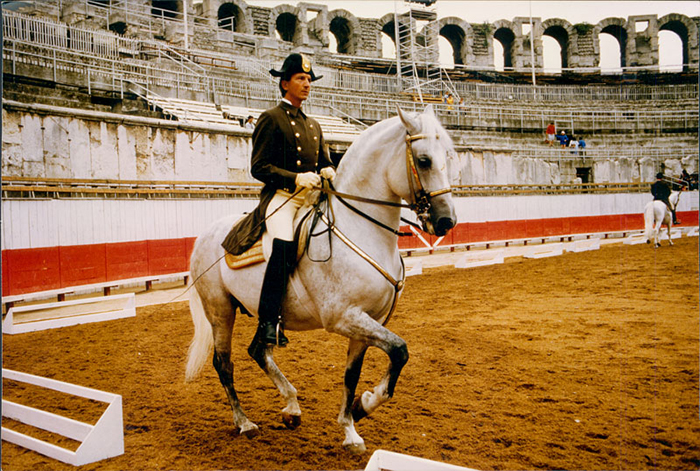
“By then, I was a pretty good traveler. I had been routinely flying to teach clinics, but this trip made me more anxious than any I could remember. A lot was at stake. I knew the literature related to the Spanish Riding School inside and out, and it all made sense to me. I was using a great deal of their training system as a blueprint for my own work. But what if, when I saw it firsthand, there was a disconnect? What if when I saw it live, it turned out that I had misinterpreted it? What if it was different from the books and photos when I was there in person? Too late for second thoughts – I was on my way.”
On his way to his clean, well-lighted place, the destination he’d been seeking:
“It was like a dream. I could see everything perfectly in the arena before me, and it didn’t take long for me to realize that everything I had read about the Spanish Riding School of Vienna was real. There was no disconnect: it was consistently the highest level of dressage I had ever seen, and yet it was in real life. Young horses acted out or clamored up the kickboards or bolted into the middle of the arena, yet no one got upset. It was as if the ritual, the tradition, the knowledge of the system was larger than any individual.”

“During the performance that day, I thought about what I had witnessed during my time at the Spanish Riding School. Philosophically, the German system was based on business, breeding programs, auctions, incentives for breeders. Competitions wereplaces to prove the value of the product. Riders became salesmen for the ‘company’. They promoted the product, took commissions,and received bonuses. What I had just watched at theSchool was practically the opposite. When I was there, the school horses were bred almost entirely for the School’s own use. The riders didn’t own them, and they were not for sale. There was no sales business to speak of. Art came first. It was performance art at a very high level; a piece of art laden with symbols.”
“What was its message? The riders wore hats that were relics of the past. Their coats were not the bright velvets and gold braid of the Portuguese bullfighters or the Cadre Noir, but a simple earthy brown. The whips they carried were branches of birch wood. There had been a careful, conscious effort to createan image that was not ostentatious, but humble; yet it was performed in an exquisite theater with brilliant chandeliers and aseating area reserved for royalty. In this there was irony. The riders performed in uniform, yet just when one felt it was a little too militaristic, a rider would reach behind his back to take a piece ofsugar from the ‘sugar pocket’ sewn permanently into his coat.”
“The airs I saw at the Spanish Riding School were the best I had ever seen, and I realized they were a product of the best collection I had ever seen. It was the system of training there, always checked by the idea that this High School was the end result, which purified the practice. The obsession with perfectrider position could save a rider’s life in a courbette. Theobsession with straightness assured that as the difficulty of theexercises increased, the work would not inordinately stress the horse’s body, risking injury. The obsession with impulsion wouldbe a rider’s doctoral thesis in the forces of energy. Every exerciseat the School had a reason and purpose, and therefore, a proper execution. There were rules to follow and mentors to watch and copy. The goals were clear and could be explained and evaluated.The proof, in the end, of the greatness of the system was not inthat it produced a once-in-a-lifetime horse or a rider that peoplecould point to. Instead, it was a school that could replicate asuperior performance, generation after generation, for 400 years.As long as the anatomy of horses and riders did not appreciably change, the system was valid and vibrant.”
The rest of the book looks a lot at the problems of competitive dressage:
“The problem with dressage competitions is that many judges are also actively in the horse business. They teach lessons, court elite riders, train horses, buy and sell horses, and breed horses, which makes these judges extremely vulnerable to conflicts of interest. At least three high-ranking dressage judges in the United States breed or have bred and sold Warmblood horses. I’m not suggesting that there is mass corruption, but the design of the system lends itself, at every level, to influence, manipulation, and bias. In the same 2010 statistical analysis of over 45,000 dressage riders I just mentioned, the authors of the paper found, alarmingly, that there was a 10 to 13 percent variability among judges. To put this in perspective, you could ride the same exact test at two shows with two different judges and score as much as 13 percent lower at one show than the other.”
And Paul is no stay-at-home critic, lashing competitors from the comfort of their own indoor:
“I have been involved in dressage competitions for 45 years, competing at all levels, and in administration of shows at all levels, from USDF-recognized shows to CDIs.”
So is there an inherent conflict between the two dressages? Again, Belasik’s suggestions are from the left field:
“If we go back to the question of whether classical and competitive dressage are compatible, there are several key factors that shape the discussion. The first is, just as The Principles of Riding ended the repertoire of dressage before the airs above the ground, interestingly, so did competitive dressage. This is an arbitrary ceiling. Due to media coverage of competitive dressage, the public and most riders have now been trained to believe that the highest level of dressage is the competition test at Grand Prix. This false ceiling unfortunately directly conflicts with, at a minimum, 400 years of classical dressage literature. The sacrifice is a proper understanding of collection. Viewers and riders alike have little idea that the equestrian feat of say, a courbette of five to six jumps in the air, landing on the horse’s hind legs alone, was in fact far more advanced than the Grand Prix requirements of piaffe and passage, or that the sublime balance of the levade was part of and proof of classical training. In the end, I think one could say that, at this moment in time, classical dressage and competitive dressage coexist, but if one accepts the definition of compatible to be ‘two things able to coexist or occur together without conflict’, then they are not compatible. There is too much provable conflict.”
It often worries me that dressage riders in Australia obsess about the almost non-existent chance of riding in a WEG or a Games, yes it is important to keep those competitions in mind, but there is much satisfaction to be had riding the perfect half pass in your own arena, impressing only the family of magpies squabbling at C.
more follows
Belasik again:
“What if dressage was instead about reaching a place where you are near the ‘best idea’ of yourself? You might not be famous, but your horse likes and respects you, people like and respect you. You work hard, but you’re not nervous about the outcome. How you feel about your work won’t change much because of some judge’s opinion. You are less concerned with how you measure up to an external yardstick because you are seriously engaged in how you meet standards established by your own tests. When you are riding, training, or teaching, you are so focused, you are often unaware of time. Even when a session is difficult, you feel right with your horse.”
Enough, I could go on and on reveling in the quotes from this important book, but I hope I have written enough that you will be determined to go out and get your own copy. The great thing about a book like this is that while you may not agree with every word, it makes you think. Think. Think about that.
It is just over twelve months since my friend Miguel Tavora died. I think of him often, how I wish I could pick up the phone and talk about Paul’s book with him…
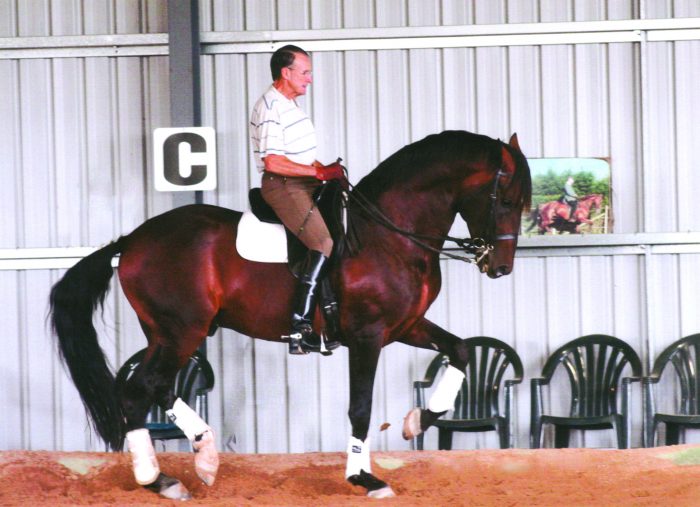
Miguel working at his school at home…



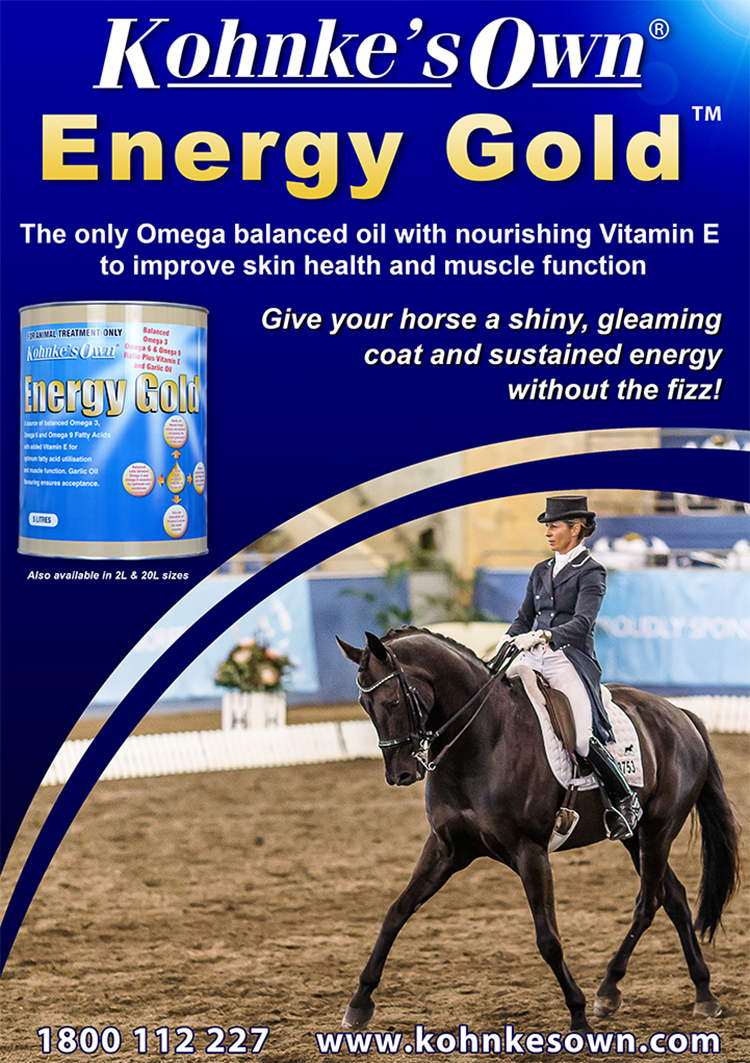


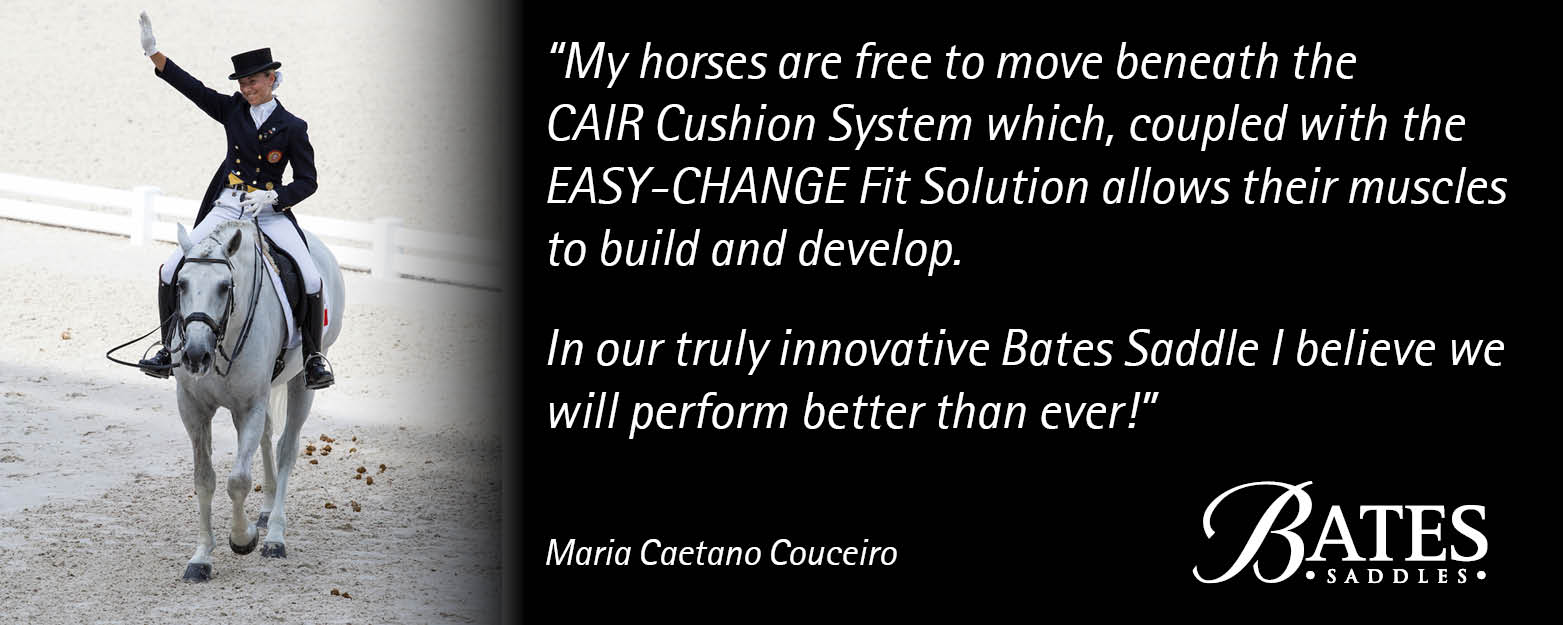
Well done Chris, a great revue! I have been a fan of Paul Belasik since I found his first book ‘Riding towards the Light’ was it? Love his searching…& now it’s so important, with a camera at every corner to record our mistakes!
Very interesting. I have coach people who were devotees of Paul. They all tried to elevate the forehand by pulling mechanically the horse’s head up! There was absolutely no collection. The horse was hollow with a dropped back and falsely elevated neck and head. As regards Paul’s assertion that we should not stop at GP surely he would have noticed at the Spanish Riding School that not all horses could do all the aires above the ground. They have “specialists “. I had the great fortune to ride a lovely horse at Miguel’s who did levade. I too wish Miguel was here to write a rebuttal.
Thanks for such a balanced and insightful review. I immediately purchased Miguel Tavora’s ‘Dressage Principles and Techniques A Blueprint for the Serious Rider’ when you reviewed it, and I have read and re-read it many times; it is THE book for all classical dressage enthusiasts.
It’s clear that Miguel Tavora developed his own training system, even though he was a student of Nuno Oliveira’s, because his book is all about the gradual, progressive, logical and systematic, gymnastic work of the horse -his views were very clearly not tainted by those of Baucher; as Belasik claims Nuno Oliveira was. When you read the many quotes (including some from Baucher) it shows how he (Tavora) took pieces of wisdom from the masters that he felt he could use in his own methods.
I’m off to order my copy of ‘Dressage For No Country’, thank you for the heads up Christopher! 🙂